Freshwater Fishing Heaven: Brazil Peacock Bass & More
Tim Herald 02.28.18
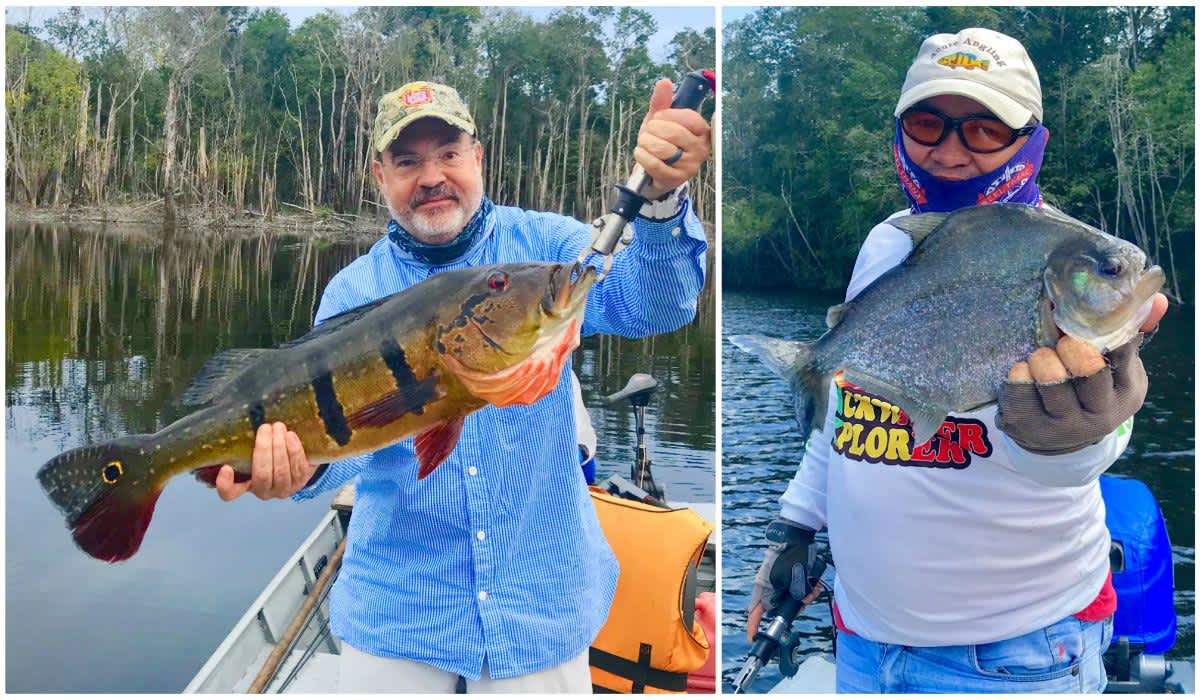
I recently returned from a trip to the Amazon basin with a small group of anglers/friends to fish for the aggressive peacock bass. This was a trip to get firsthand knowledge of an outfitter we wanted to add to the WTA stable, and we really strive to have boots on the ground, or in this case, flip flops on the deck.
I’d done a lot of research on the operation, and have several personal friends who have fished there, but there is nothing like a trial run in person, especially because WTA has a Cabela’s Visa Signature Outdoor Adventure planned there in the future.
About 10 years ago I’d been to this area, and it was one of my all-time favorite trips. I’m much more of a hunter than a fisherman, but I grew up fishing a lot with my family, and it is still a passion for me. The peacock bass is the most aggressive and pound for pound hardest-fighting freshwater fish I’ve ever battled, and I absolutely couldn’t wait to get back on the waters of the Rio Negro.
This was a package deal outside of international airfare and tips, so that made things very easy. Our group from all around the U.S. met in Miami, where we took the 5-hour flight to Manuas, Brazil, South America. This a large city in the middle of the jungle, and is located where the two main branches of the Amazon converge and become the Amazon River proper.
It was late, so we went to a nice hotel and crashed. The next morning, we were taken back to the airport, where we caught a charter to Barcelos, a small town on the Rio Negro. We transferred our gear to our “mother ship” (below) and away we went chugging upstream.

By the time we had unpacked, settled in and eaten a good lunch, the big boat had stopped, and we all went out for the afternoon to fish. We caught a decent number of peacocks that afternoon (probably 25 per boat of two anglers), despite a heavy cloudburst, and we quit fishing at 5 p.m.

The next morning, we were on the water at 6 a.m., and the fishing was even better. I think the first fish over 10 pounds was caught that morning. For the next 6 days, we fished mornings and afternoons, and at midday, we either came back to the big boat for a delicious lunch in the air-conditioned dining room and a siesta, or some chose to take lunch and eat on shore from a hammock.

It seemed that we caught more and bigger fish each day. Some of that was due to getting to more remote areas, and I think some also was also due to our fishing proficiency getting better each day. The water was just a little high, and that made casting accuracy even more important.
My good friend and long-time WTA client Tom Neiderer and his buddy Troy Wisely were the most serious and talented fishermen of the group, and the number of fish they caught was astounding. The duo landed more than 100 fish every full day on the water, and the number of 10- to 17-pound bruisers they boated was very high.
The highest 1-day total was turned in by Mike Burke and Toby Blissett. This Louisiana tandem caught 168 peacock bass between daylight and dark. That was some serious fishing.
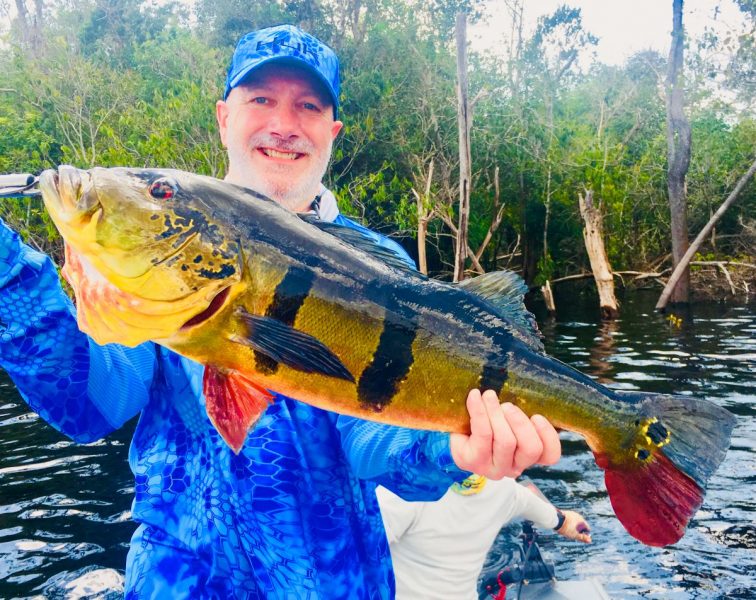
We didn’t break the magic 20-pound mark on this trip, but I think that was because of the high and rising water. During my last trip, everyone caught a 20-pounder, and the largest weighted 23. As I said, there were a lot of fish in the 10- to 17-pound class, with Tom Neiderer’s 17 taking the big fish pool for the week (which he graciously gave to his guide as a bonus tip).
In the end, we landed 1,756 peacock bass, and the guides didn’t count all the other species we caught. I love variety, and bringing in the occasional piranha (which I love to eat), various “other cichlids,” and one of my favorites was the very pike- or barracuda-like bicuda. I caught a good-sized bicuda that spent more time in the air than in the water during one crazy battle.
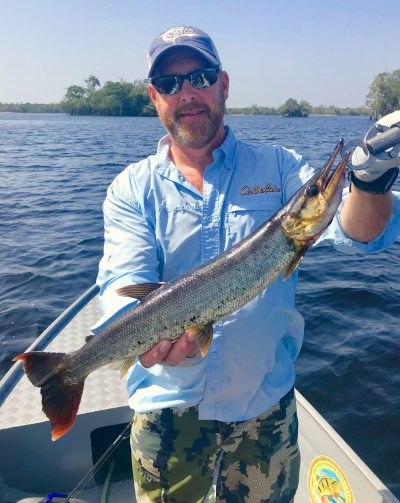
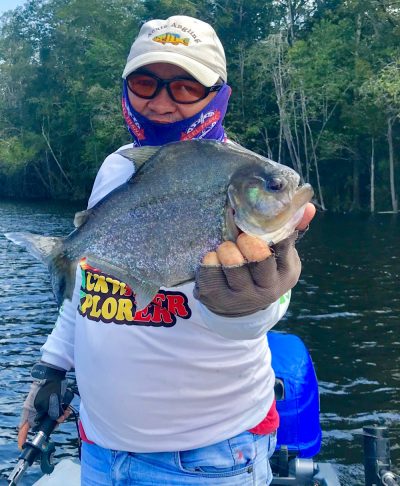
We saw moneys, pink dolphins, very large caimans, Amazon parrots, macaws, and lots of other interesting animals. The fact that we went in late January/early February was nice as far as getting out of the frigid winter back home in the United States.
On our last day, we chartered from Barcelos to Manuas, where we were given day rooms at the hotel. We went out and explored the city, seeing the beautiful opera house (which was built by rubber barons), the town square, the fish market, and finally ending the day at a traditional Brazilian steakhouse, Buffalo.

That night a little after midnight, we flew back to America where most of the group was home in the morning. I flew straight out to the SCI (Safari Club International) Show in Las Vegas, and you can believe I was tired when I hit the sack that evening.
Overall, this is a very affordable trip that any serious (or in my case, not so serious) fisherman needs to put on their bucket list. The Amazon is a magical place, and peacock bass fishing is one of the most fun trips an angler can take. It’s an easy and safe trip, and I for one can’t wait to go back.
Sidebar: Gear for the Amazon
It is hot in the Amazon basin, and the sun is intense. You need to keep covered up, and protect yourself from the sun, but you want to stay as cool as possible. My favorite combination on this trip was a lightweight Performance Vented T-shirts from HUK Performance Fishing, along with one of its lightweight gaiters to cover neck, face and ears. Both products provide sun protection, ultimate breathability, moisture transport and are incredibly breathable.
I wore KUIU Tiburon shorts, and these lightweight breathable shorts are also built for high temperatures. The lightweight Tiburon fabric has two-way stretch, is light, breathable, and quick drying. I also took Tiburon pants in case I got sunburned and wanted to stay completely covered, but I used enough 70 spf sunscreen on my legs that I never had to deal with that.
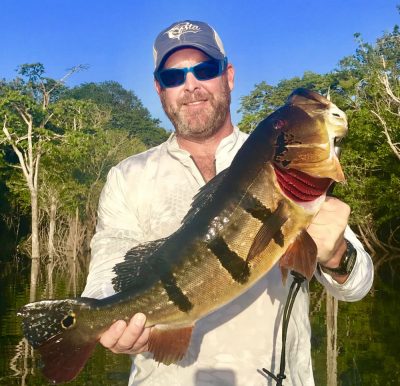
For seeing beneath the tea-colored water, reducing glare, and for sun protection, I wore my favorite Costa Corbina sunglasses. Corbinas are ultra-comfortable with nonslip Hydrolite construction that is really handy in the high humidity where you are always sweating and covered in sunscreen. The wide temples and large lenses help with glare all around. Mine have blue mirror lenses, which are great for reflective water. I can’t imagine fishing without my Costas.
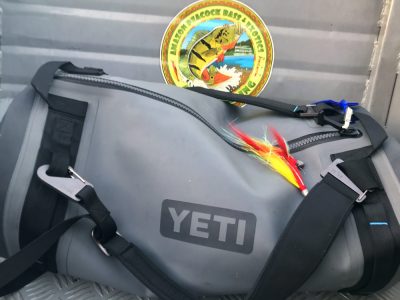
Finally, a product I used on this trip that was nothing short of fantastic was the YETI Panga 50 dry duffle bag. Because the outfitter staff does your laundry every day on the boat, you don’t need a ton of clothes, so this 23.5x10x14-inch bag that has comfortable and easily removable backpack straps was perfect as my luggage. Then I loaded it with rainsuit, long pants, sunscreen, extra lures, camera, phone, snacks, and anything else I needed in the boat for the day, knowing it would be completely dry whether we were caught in a heavy thunderstorm, a big peacock bass was dropped and flopped around in the bottom of the boat, or it was dropped in the river itself. This was my first trip using the Panga, and I was really impressed.
Editor’s note: Tim Herald is an owner and hunt consultant at Worldwide Trophy Adventures (WTA). To book this or any other high-quality hunt anywhere in the world, contact Tim at tim@trophyadventures.com. WTA’s services are free; WTA is paid directly by the outfitter, and your hunt cost is the same whether you book directly with an outfitter or through WTA.


